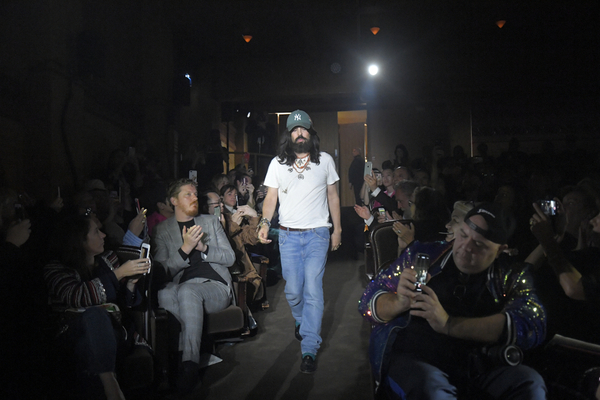For the last few years the death of the fashion show — and fashion weeks in general — has been proclaimed with the same bated-breath relish as the end of the foie gras goose, but, as recently reported in The New York Times, don’t be so sure about that, because some top profile peeps in the fashion industry beg to differ.
First it was Instagram and the smartphone that would kill the show: the see now/buy now need for immediate gratification trouncing the traditional cycle. That turned out to be not entirely true (or it turned out there were ways around it), but then — the multi-platform direct-to-consumer “experience” was going to kill the show, because, well, we all could just do our own thing as we saw fit.
That turned out to be not entirely true either — many designers’ own thing was the old thing — but recently the fashion naysayers were at it again, declaring that the current drive toward sustainability might kill the fashion show. After all, with its intense travel and production requirements, the seasonal collection circuit exacts a heavy environmental toll. It is true that the only genuinely sustainable fashion week is no fashion week at all. Coming at the same time as New York and London fashion weeks that were palpably low-energy, that idea seemed to be picking up steam.
Then Alessandro Michele of Gucci held up his ring-bedecked, green-and-blue manicured hand. Hold on a minute. Why are shows not over? Why might they never be over? Step this way, if you please. Enter through a black-draped doorway to a brightly lit space of mirrors, makeup tables and white-robed models getting manicures. Wait. Are we backstage? Is this the wrong entrance? No, get out your phone; you get to see how the pudding is made.
File straight ahead to your seat on benches arrayed in a circle around a central stage covered in a lavender shroud; after you, the models and the hair and makeup people, filing quietly into the middle. Up come the strains of Ravel’s “Bolero,” down drops the curtain to puddle on the floor, and there the models all are, trapped behind clear glass, shedding their robes and being clothed by an army of gray-suited dressers.
Gradually they step to the front and stand like dolls in a row: in ballooning brocade Scarlett O’Hara ball gowns and shrunken little-girl velvets with big white Peter Pan collars; in faded, ripped jeans and smocked velvet; in crucifixes and leather harnesses; in granny sweaters and peasant florals; in all the flibbertigibbet, eccentric, everything-goes finery Mr. Michele has become known for — as the stage begins to rotate like a merry-go-round and, in the middle, a big neon metronome ticks backs and forth.
“I wanted to say fashion is a complex mechanism and something sacred,” Mr. Michele said after the show, resplendent in red plaid shirt over white tee, and emerald green corduroys, like a backwoods refugee from Santa’s workshop, free-associating among religion, childbirth, Fellini and physics. Circus found its way in there, too. And the liturgy.
“We all come for this ritual that is almost religious,” he went on. “In our world it is very important, and I really want to go on repeating this ritual. We say ‘one day I want to stop and do something else,’ but that day never comes. I’m 48 years old and have not found something else.” So instead he created a show about the making of a show; the behind-the-scenes brought forth and shared for the age of the sharing economy. If it was more the performance of transparency than the actual fact; a simulacrum of intimacy — Mr. Michele issued a “personal invitation” to the show via a voice mail message on WhatsApp, though every attendee got exactly the same one — it was also something to see.
He tends to exaggerate and overdecorate, but under the hyperbole is a kernel of truth. It’s why his work has resonance. Whether you worship on the altar of fashion or roll your eyes in horror and sacrilege at the metaphor, dressing is itself a kind of minor daily ritual, and clothes are what we all wear to perform our lives. A fashion show has always been, and still is, the most concentrated reminder of that.
Even Alberta Ferretti, with her unapologetic ode to ’80s and ’90s revivalism in the form of shoulder pads! and high-waist pleated leather pants! and gold chains à go-go!, was creating a character. Albeit one we’ve seen before, and may not want to see again, especially in such literal form. It was clearer, in any case, than Max Mara’s pinstriped Aqua-execs, in their ruffle-scale-sleeve navy, beige and brown suiting, rope-belted high-tide trousers and whale-size puffers.
But it’s a point that was underscored in a subtler way at Jil Sander, where Luke and Lucie Meier gracefully balanced pristine monochromatic tailoring and a curvaceous classicism in a silent pantomime of communion between opposites: graceful white and black dresses (pin-tucked, puffed out) and soft power jackets; swaddling dawn-sky knits and yards of swaying silken fringe. They were less preachy, a more convincing way to go in peace.
Peace, Love and Fashion.
—
Photo Credit: FashionStock.com / Shutterstock.com
